Abstract
1. The effects of several agonists of the metabotropic glutamate receptor (mGluR) were studied in adult rat striatal slices by measuring (i) KCl (30 mM)-induced output of previously taken up D-[3H]-aspartate (Asp), (ii) forskolin (30 microM)-induced adenosine 3':5'-cyclic monophosphate (cyclic AMP) accumulation and (iii) phophoinositide (PI) hydrolysis. 2. K(+)-induced efflux of D-[3H]-Asp was inhibited by the following mGluR agonists: (1S,3S,4S)-(carboxycyclopropyl)glycine (L-CCG-I), (1S,3R)-1-aminocyclopentane-1,3-dicarboxylic acid (1S,3R-ACPD) and quisqualic acid (Quis). 2-Amino-4-phosphonobutyrate (L-AP4) was inactive up to 300 microM. The maximal inhibition of D-[3H]-Asp output was 60 +/- 8%. The EC50s of mGluR agonists were: 0.5 microM for L-CCG-I, 100 microM for 1S,3R-ACPD and 100 microM for Quis. 3. Forskolin-induced cyclic AMP accumulation was also inhibited by mGluR agonists. The maximal inhibition was 50 +/- 4% and was obtained at a concentration of 10 microM for L-CCG-I and 100 microM for 1S,3R-ACPD. The EC50s for this inhibition were: 0.9 microM for L-CCG-I and 20 microM for 1S,3R-ACPD. Quis (300 microM) inhibited cyclic AMP accumulation by approximately 20%. L-AP4 slightly potentiated cyclic AMP accumulation. 4. PI hydrolysis was stimulated by mGluR agonists. The most potent compound was Quis (100 microM), which increased inositol phosphate formation up to 2.2 fold over control values. Its EC50 was 15 microM. L-CCG-I and 1S,3R-ACPD increased inositol phosphate formation by approximately 1.8 fold and their EC50 values were 30 and 25 microM, respectively. L-AP4 did not affect PI hydrolysis.(ABSTRACT TRUNCATED AT 250 WORDS)
Full text
PDF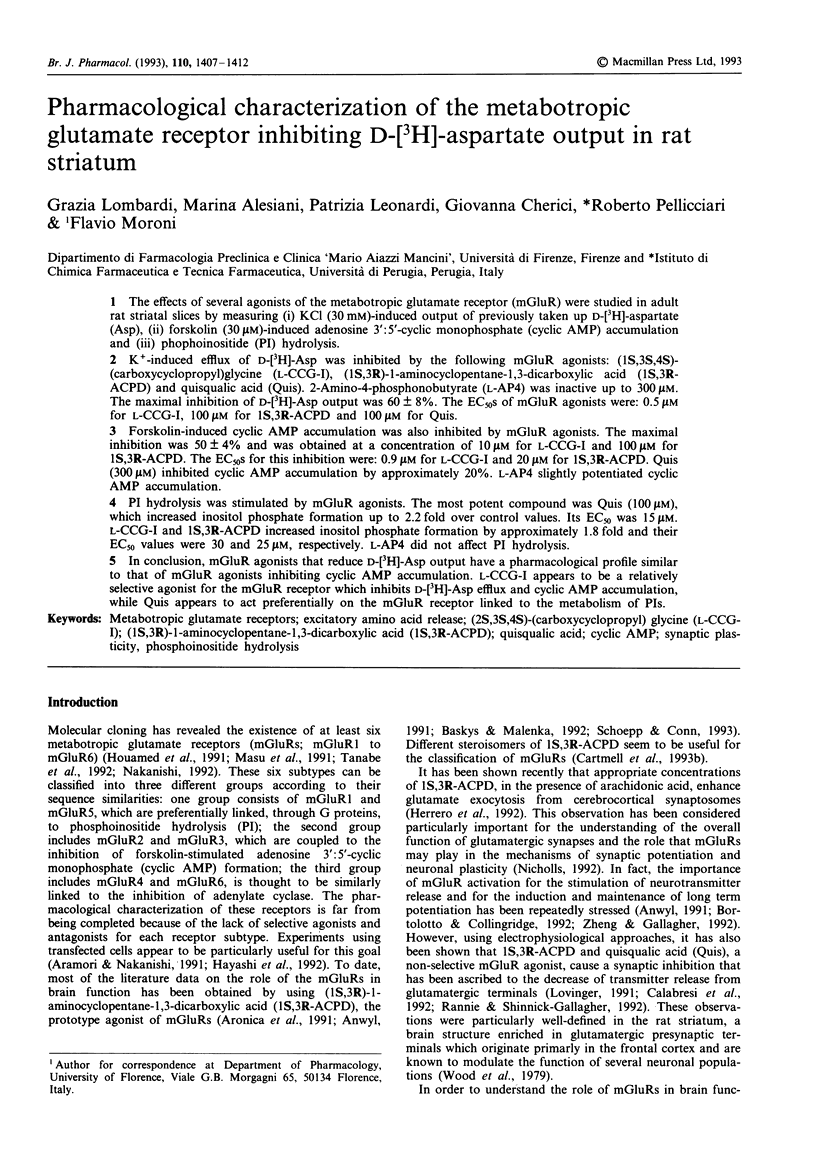
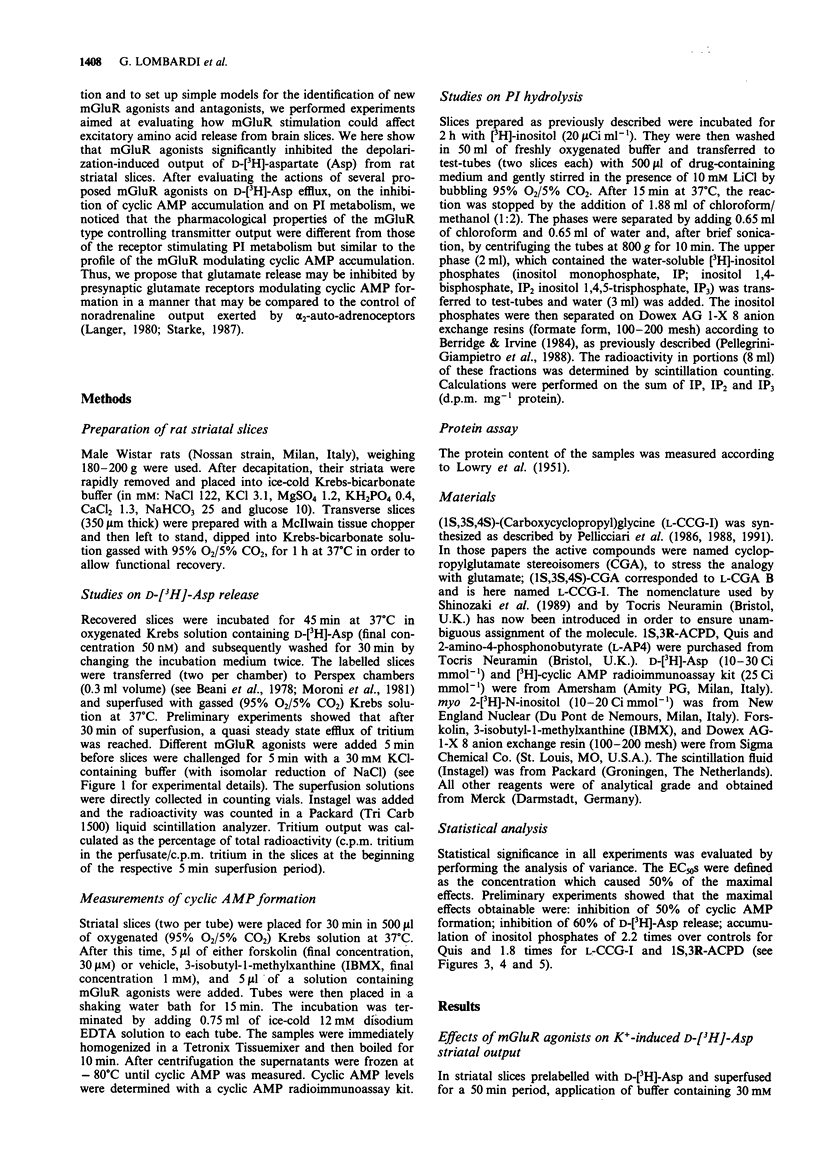
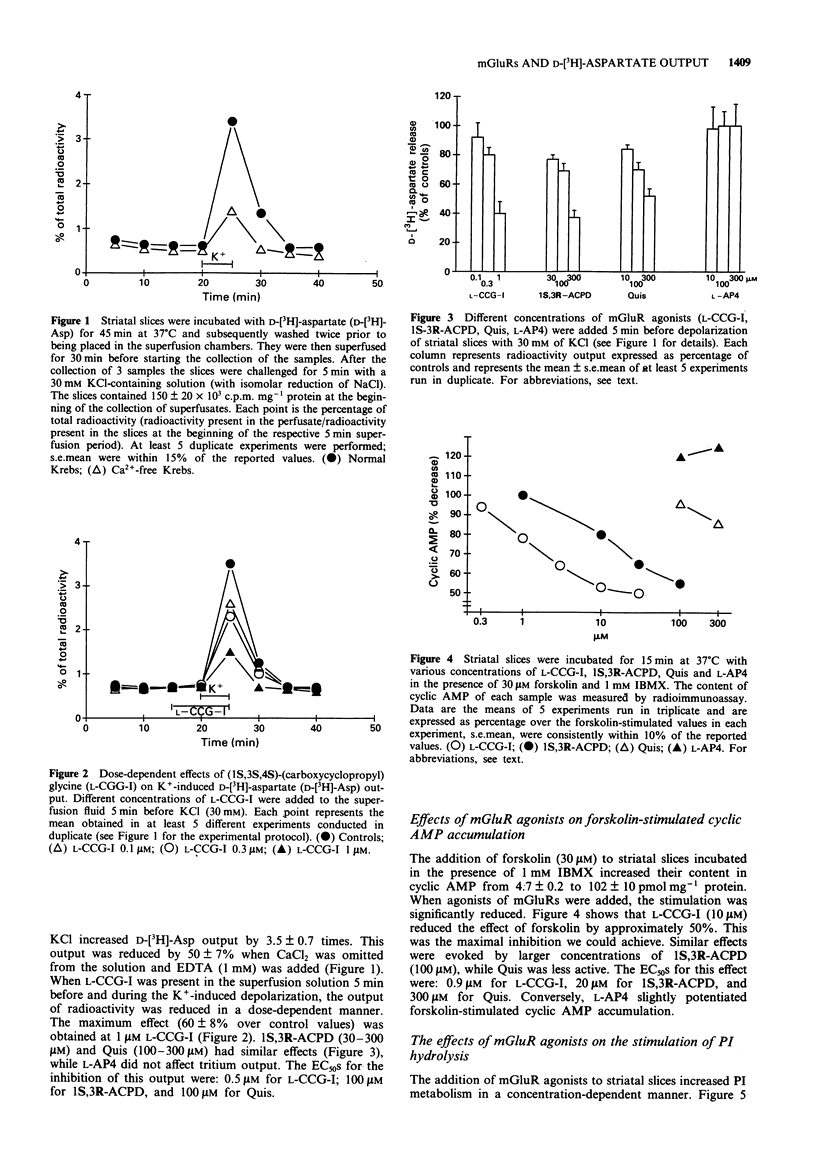
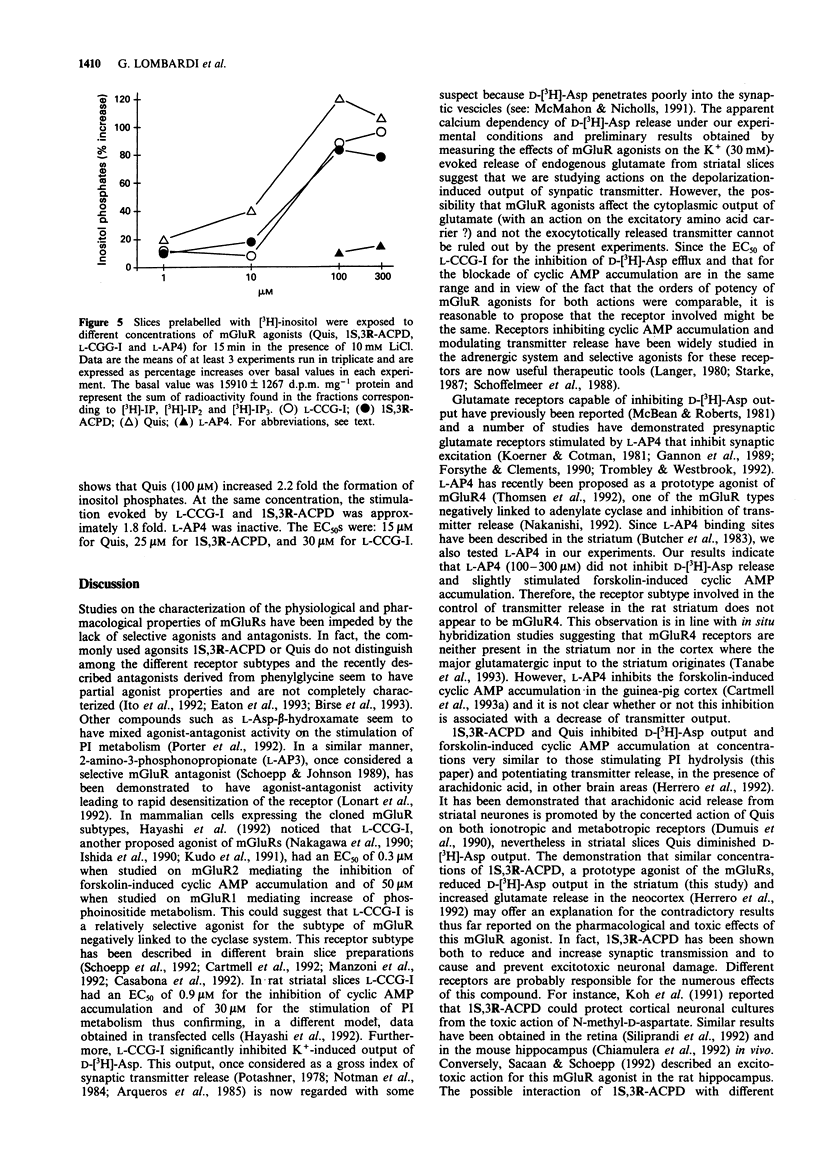
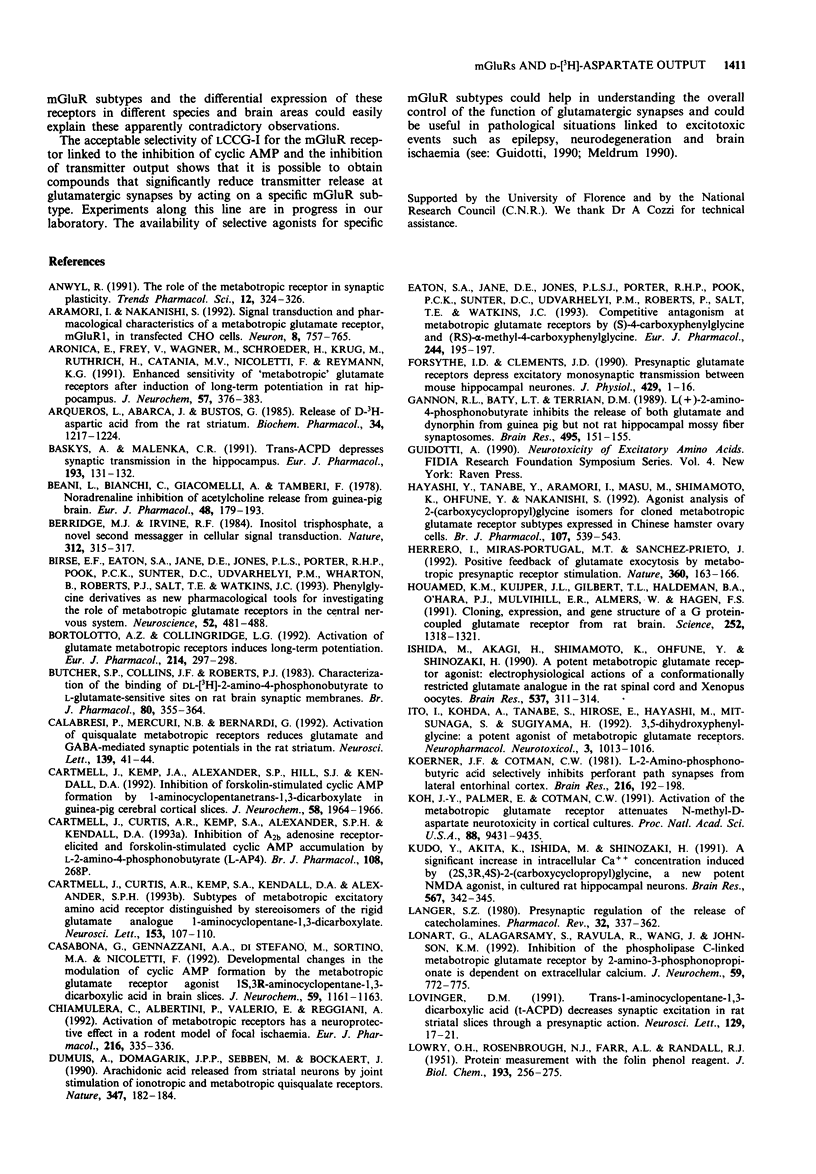
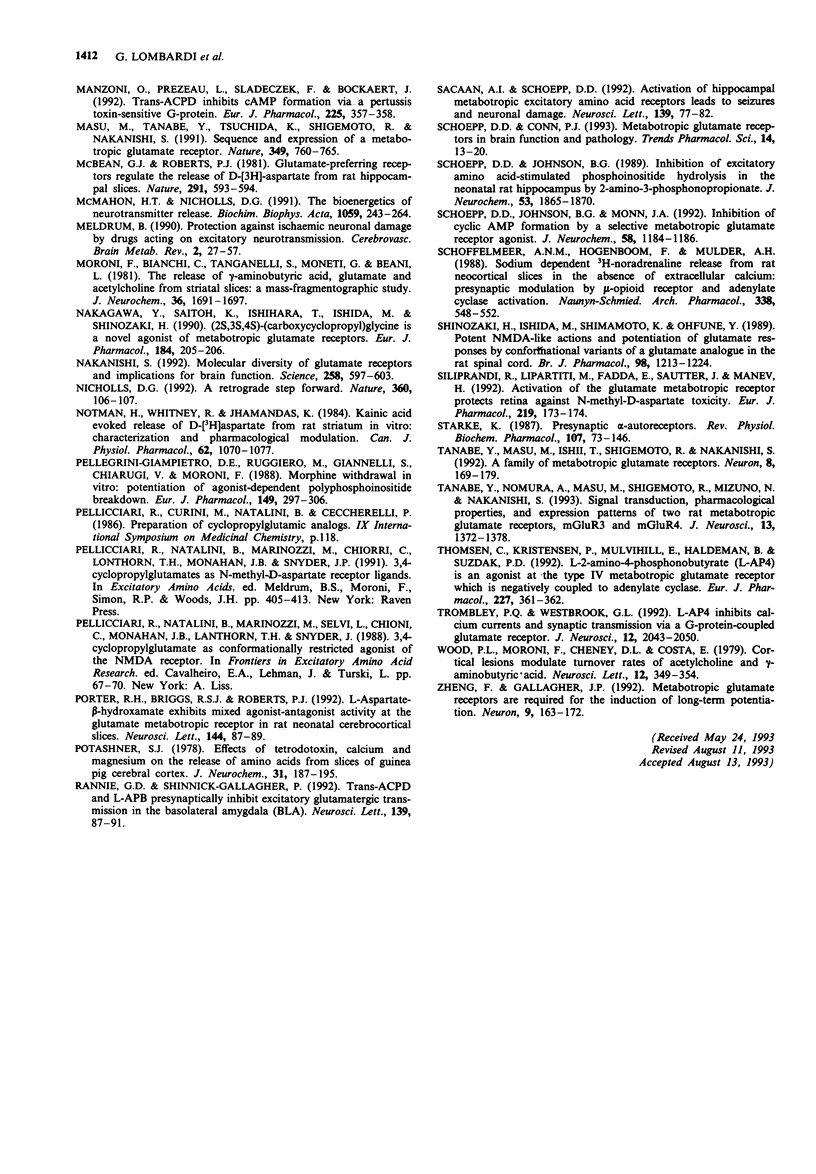
Selected References
These references are in PubMed. This may not be the complete list of references from this article.
- Anwyl R. The role of the metabotropic receptor in synaptic plasticity. Trends Pharmacol Sci. 1991 Sep;12(9):324–326. doi: 10.1016/0165-6147(91)90588-j. [DOI] [PubMed] [Google Scholar]
- Aramori I., Nakanishi S. Signal transduction and pharmacological characteristics of a metabotropic glutamate receptor, mGluR1, in transfected CHO cells. Neuron. 1992 Apr;8(4):757–765. doi: 10.1016/0896-6273(92)90096-v. [DOI] [PubMed] [Google Scholar]
- Aronica E., Frey U., Wagner M., Schroeder H., Krug M., Ruthrich H., Catania M. V., Nicoletti F., Reymann K. G. Enhanced sensitivity of "metabotropic" glutamate receptors after induction of long-term potentiation in rat hippocampus. J Neurochem. 1991 Aug;57(2):376–383. doi: 10.1111/j.1471-4159.1991.tb03763.x. [DOI] [PubMed] [Google Scholar]
- Arqueros L., Abarca J., Bustos G. Release of D-[3H]aspartic acid from the rat striatum. Effect of veratridine-evoked depolarization, fronto-parietal cortex ablation, and striatal lesions with kainic acid. Biochem Pharmacol. 1985 Apr 15;34(8):1217–1224. doi: 10.1016/0006-2952(85)90498-8. [DOI] [PubMed] [Google Scholar]
- Baskys A., Malenka R. C. Trans-ACPD depresses synaptic transmission in the hippocampus. Eur J Pharmacol. 1991 Jan 25;193(1):131–132. doi: 10.1016/0014-2999(91)90213-a. [DOI] [PubMed] [Google Scholar]
- Beani L., Bianchi C., Giacomelli A., Tamberi F. Noradrenaline inhibition of acetylcholine release from guinea-pig brain. Eur J Pharmacol. 1978 Mar 15;48(2):179–193. doi: 10.1016/0014-2999(78)90327-8. [DOI] [PubMed] [Google Scholar]
- Berridge M. J., Irvine R. F. Inositol trisphosphate, a novel second messenger in cellular signal transduction. Nature. 1984 Nov 22;312(5992):315–321. doi: 10.1038/312315a0. [DOI] [PubMed] [Google Scholar]
- Birse E. F., Eaton S. A., Jane D. E., Jones P. L., Porter R. H., Pook P. C., Sunter D. C., Udvarhelyi P. M., Wharton B., Roberts P. J. Phenylglycine derivatives as new pharmacological tools for investigating the role of metabotropic glutamate receptors in the central nervous system. Neuroscience. 1993 Feb;52(3):481–488. doi: 10.1016/0306-4522(93)90400-a. [DOI] [PubMed] [Google Scholar]
- Bortolotto Z. A., Collingridge G. L. Activation of glutamate metabotropic receptors induces long-term potentiation. Eur J Pharmacol. 1992 Apr 22;214(2-3):297–298. doi: 10.1016/0014-2999(92)90135-q. [DOI] [PubMed] [Google Scholar]
- Butcher S. P., Collins J. F., Roberts P. J. Characterization of the binding of DL-[3H]-2-amino-4-phosphonobutyrate to L-glutamate-sensitive sites on rat brain synaptic membranes. Br J Pharmacol. 1983 Oct;80(2):355–364. doi: 10.1111/j.1476-5381.1983.tb10041.x. [DOI] [PMC free article] [PubMed] [Google Scholar]
- Calabresi P., Mercuri N. B., Bernardi G. Activation of quisqualate metabotropic receptors reduces glutamate and GABA-mediated synaptic potentials in the rat striatum. Neurosci Lett. 1992 May 11;139(1):41–44. doi: 10.1016/0304-3940(92)90852-x. [DOI] [PubMed] [Google Scholar]
- Cartmell J., Curtis A. R., Kemp J. A., Kendall D. A., Alexander S. P. Subtypes of metabotropic excitatory amino acid receptor distinguished by stereoisomers of the rigid glutamate analogue, 1-aminocyclopentane-1,3-dicarboxylate. Neurosci Lett. 1993 Apr 16;153(1):107–110. doi: 10.1016/0304-3940(93)90088-3. [DOI] [PubMed] [Google Scholar]
- Cartmell J., Kemp J. A., Alexander S. P., Hill S. J., Kendall D. A. Inhibition of forskolin-stimulated cyclic AMP formation by 1-aminocyclopentane-trans-1,3-dicarboxylate in guinea-pig cerebral cortical slices. J Neurochem. 1992 May;58(5):1964–1966. doi: 10.1111/j.1471-4159.1992.tb10077.x. [DOI] [PubMed] [Google Scholar]
- Casabona G., Genazzani A. A., Di Stefano M., Sortino M. A., Nicoletti F. Developmental changes in the modulation of cyclic AMP formation by the metabotropic glutamate receptor agonist 1S,3R-aminocyclopentane-1,3-dicarboxylic acid in brain slices. J Neurochem. 1992 Sep;59(3):1161–1163. doi: 10.1111/j.1471-4159.1992.tb08360.x. [DOI] [PubMed] [Google Scholar]
- Chiamulera C., Albertini P., Valerio E., Reggiani A. Activation of metabotropic receptors has a neuroprotective effect in a rodent model of focal ischaemia. Eur J Pharmacol. 1992 Jun 5;216(2):335–336. doi: 10.1016/0014-2999(92)90382-e. [DOI] [PubMed] [Google Scholar]
- Dumuis A., Pin J. P., Oomagari K., Sebben M., Bockaert J. Arachidonic acid released from striatal neurons by joint stimulation of ionotropic and metabotropic quisqualate receptors. Nature. 1990 Sep 13;347(6289):182–184. doi: 10.1038/347182a0. [DOI] [PubMed] [Google Scholar]
- Eaton S. A., Jane D. E., Jones P. L., Porter R. H., Pook P. C., Sunter D. C., Udvarhelyi P. M., Roberts P. J., Salt T. E., Watkins J. C. Competitive antagonism at metabotropic glutamate receptors by (S)-4-carboxyphenylglycine and (RS)-alpha-methyl-4-carboxyphenylglycine. Eur J Pharmacol. 1993 Jan 15;244(2):195–197. doi: 10.1016/0922-4106(93)90028-8. [DOI] [PubMed] [Google Scholar]
- Forsythe I. D., Clements J. D. Presynaptic glutamate receptors depress excitatory monosynaptic transmission between mouse hippocampal neurones. J Physiol. 1990 Oct;429:1–16. doi: 10.1113/jphysiol.1990.sp018240. [DOI] [PMC free article] [PubMed] [Google Scholar]
- Gannon R. L., Baty L. T., Terrian D. M. L(+)-2-amino-4-phosphonobutyrate inhibits the release of both glutamate and dynorphin from guinea pig but not rat hippocampal mossy fiber synaptosomes. Brain Res. 1989 Aug 21;495(1):151–155. doi: 10.1016/0006-8993(89)91229-8. [DOI] [PubMed] [Google Scholar]
- Hayashi Y., Tanabe Y., Aramori I., Masu M., Shimamoto K., Ohfune Y., Nakanishi S. Agonist analysis of 2-(carboxycyclopropyl)glycine isomers for cloned metabotropic glutamate receptor subtypes expressed in Chinese hamster ovary cells. Br J Pharmacol. 1992 Oct;107(2):539–543. doi: 10.1111/j.1476-5381.1992.tb12780.x. [DOI] [PMC free article] [PubMed] [Google Scholar]
- Herrero I., Miras-Portugal M. T., Sánchez-Prieto J. Positive feedback of glutamate exocytosis by metabotropic presynaptic receptor stimulation. Nature. 1992 Nov 12;360(6400):163–166. doi: 10.1038/360163a0. [DOI] [PubMed] [Google Scholar]
- Houamed K. M., Kuijper J. L., Gilbert T. L., Haldeman B. A., O'Hara P. J., Mulvihill E. R., Almers W., Hagen F. S. Cloning, expression, and gene structure of a G protein-coupled glutamate receptor from rat brain. Science. 1991 May 31;252(5010):1318–1321. doi: 10.1126/science.1656524. [DOI] [PubMed] [Google Scholar]
- Ishida M., Akagi H., Shimamoto K., Ohfune Y., Shinozaki H. A potent metabotropic glutamate receptor agonist: electrophysiological actions of a conformationally restricted glutamate analogue in the rat spinal cord and Xenopus oocytes. Brain Res. 1990 Dec 24;537(1-2):311–314. doi: 10.1016/0006-8993(90)90375-l. [DOI] [PubMed] [Google Scholar]
- Ito I., Kohda A., Tanabe S., Hirose E., Hayashi M., Mitsunaga S., Sugiyama H. 3,5-Dihydroxyphenyl-glycine: a potent agonist of metabotropic glutamate receptors. Neuroreport. 1992 Nov;3(11):1013–1016. [PubMed] [Google Scholar]
- Koerner J. F., Cotman C. W. Micromolar L-2-amino-4-phosphonobutyric acid selectively inhibits perforant path synapses from lateral entorhinal cortex. Brain Res. 1981 Jul 6;216(1):192–198. doi: 10.1016/0006-8993(81)91288-9. [DOI] [PubMed] [Google Scholar]
- Koh J. Y., Palmer E., Cotman C. W. Activation of the metabotropic glutamate receptor attenuates N-methyl-D-aspartate neurotoxicity in cortical cultures. Proc Natl Acad Sci U S A. 1991 Nov 1;88(21):9431–9435. doi: 10.1073/pnas.88.21.9431. [DOI] [PMC free article] [PubMed] [Google Scholar]
- Kudo Y., Akita K., Ishida M., Shinozaki H. A significant increase in intracellular Ca2+ concentration induced by (2S,3R,4S)-2-(carboxycyclopropyl)glycine, a new potent NMDA agonist, in cultured rat hippocampal neurons. Brain Res. 1991 Dec 20;567(2):342–345. doi: 10.1016/0006-8993(91)90817-f. [DOI] [PubMed] [Google Scholar]
- LOWRY O. H., ROSEBROUGH N. J., FARR A. L., RANDALL R. J. Protein measurement with the Folin phenol reagent. J Biol Chem. 1951 Nov;193(1):265–275. [PubMed] [Google Scholar]
- Langer S. Z. Presynaptic regulation of the release of catecholamines. Pharmacol Rev. 1980 Dec;32(4):337–362. [PubMed] [Google Scholar]
- Lonart G., Alagarsamy S., Ravula R., Wang J., Johnson K. M. Inhibition of the phospholipase C-linked metabotropic glutamate receptor by 2-amino-3-phosphonopropionate is dependent on extracellular calcium. J Neurochem. 1992 Aug;59(2):772–775. doi: 10.1111/j.1471-4159.1992.tb09438.x. [DOI] [PubMed] [Google Scholar]
- Lovinger D. M. Trans-1-aminocyclopentane-1,3-dicarboxylic acid (t-ACPD) decreases synaptic excitation in rat striatal slices through a presynaptic action. Neurosci Lett. 1991 Aug 5;129(1):17–21. doi: 10.1016/0304-3940(91)90710-b. [DOI] [PubMed] [Google Scholar]
- Manzoni O., Prezeau L., Sladeczek F., Bockaert J. Trans-ACPD inhibits cAMP formation via a pertussis toxin-sensitive G-protein. Eur J Pharmacol. 1992 Apr 10;225(4):357–358. doi: 10.1016/0922-4106(92)90112-9. [DOI] [PubMed] [Google Scholar]
- Masu M., Tanabe Y., Tsuchida K., Shigemoto R., Nakanishi S. Sequence and expression of a metabotropic glutamate receptor. Nature. 1991 Feb 28;349(6312):760–765. doi: 10.1038/349760a0. [DOI] [PubMed] [Google Scholar]
- McBean G. J., Roberts P. J. Glutamate-preferring receptors regulate the release of D-[3H]aspartate from rat hippocampal slices. Nature. 1981 Jun 18;291(5816):593–594. doi: 10.1038/291593a0. [DOI] [PubMed] [Google Scholar]
- McMahon H. T., Nicholls D. G. The bioenergetics of neurotransmitter release. Biochim Biophys Acta. 1991 Sep 13;1059(3):243–264. doi: 10.1016/s0005-2728(05)80210-5. [DOI] [PubMed] [Google Scholar]
- Meldrum B. Protection against ischaemic neuronal damage by drugs acting on excitatory neurotransmission. Cerebrovasc Brain Metab Rev. 1990 Spring;2(1):27–57. [PubMed] [Google Scholar]
- Moroni F., Bianchi C., Tanganelli S., Moneti G., Beani L. The release of gamma-aminobutyric acid, glutamate, and acetylcholine from striatal slices: a mass fragmentographic study. J Neurochem. 1981 May;36(5):1691–1699. doi: 10.1111/j.1471-4159.1981.tb00420.x. [DOI] [PubMed] [Google Scholar]
- Nakagawa Y., Saitoh K., Ishihara T., Ishida M., Shinozaki H. (2S,3S,4S) alpha-(carboxycyclopropyl)glycine is a novel agonist of metabotropic glutamate receptors. Eur J Pharmacol. 1990 Aug 2;184(1):205–206. doi: 10.1016/0014-2999(90)90686-z. [DOI] [PubMed] [Google Scholar]
- Nakanishi S. Molecular diversity of glutamate receptors and implications for brain function. Science. 1992 Oct 23;258(5082):597–603. doi: 10.1126/science.1329206. [DOI] [PubMed] [Google Scholar]
- Nicholls D. G. Neurotransmission. A retrograde step forward. Nature. 1992 Nov 12;360(6400):106–107. doi: 10.1038/360106a0. [DOI] [PubMed] [Google Scholar]
- Notman H., Whitney R., Jhamandas K. Kainic acid evoked release of D-[3H]aspartate from rat striatum in vitro: characterization and pharmacological modulation. Can J Physiol Pharmacol. 1984 Sep;62(9):1070–1077. doi: 10.1139/y84-179. [DOI] [PubMed] [Google Scholar]
- Pellegrini-Giampietro D. E., Ruggiero M., Giannelli S., Chiarugi V. P., Moroni F. Morphine withdrawal in vitro: potentiation of agonist-dependent polyphosphoinositide breakdown. Eur J Pharmacol. 1988 May 10;149(3):297–306. doi: 10.1016/0014-2999(88)90660-7. [DOI] [PubMed] [Google Scholar]
- Porter R. H., Briggs R. S., Roberts P. J. L-aspartate-beta-hydroxamate exhibits mixed agonist/antagonist activity at the glutamate metabotropic receptor in rat neonatal cerebrocortial slices. Neurosci Lett. 1992 Sep 14;144(1-2):87–89. doi: 10.1016/0304-3940(92)90722-j. [DOI] [PubMed] [Google Scholar]
- Potashner S. J. Effects of tetrodotoxin, calcium and magnesium on the release of amino acids from slices of guinea-pig cerebral cortex. J Neurochem. 1978 Jul;31(1):187–195. doi: 10.1111/j.1471-4159.1978.tb12447.x. [DOI] [PubMed] [Google Scholar]
- Rainnie D. G., Shinnick-Gallagher P. Trans-ACPD and L-APB presynaptically inhibit excitatory glutamatergic transmission in the basolateral amygdala (BLA). Neurosci Lett. 1992 May 11;139(1):87–91. doi: 10.1016/0304-3940(92)90864-4. [DOI] [PubMed] [Google Scholar]
- Sacaan A. I., Schoepp D. D. Activation of hippocampal metabotropic excitatory amino acid receptors leads to seizures and neuronal damage. Neurosci Lett. 1992 May 11;139(1):77–82. doi: 10.1016/0304-3940(92)90862-2. [DOI] [PubMed] [Google Scholar]
- Schoepp D. D., Conn P. J. Metabotropic glutamate receptors in brain function and pathology. Trends Pharmacol Sci. 1993 Jan;14(1):13–20. doi: 10.1016/0165-6147(93)90107-u. [DOI] [PubMed] [Google Scholar]
- Schoepp D. D., Johnson B. G. Inhibition of excitatory amino acid-stimulated phosphoinositide hydrolysis in the neonatal rat hippocampus by 2-amino-3-phosphonopropionate. J Neurochem. 1989 Dec;53(6):1865–1870. doi: 10.1111/j.1471-4159.1989.tb09254.x. [DOI] [PubMed] [Google Scholar]
- Schoepp D. D., Johnson B. G., Monn J. A. Inhibition of cyclic AMP formation by a selective metabotropic glutamate receptor agonist. J Neurochem. 1992 Mar;58(3):1184–1186. doi: 10.1111/j.1471-4159.1992.tb09381.x. [DOI] [PubMed] [Google Scholar]
- Schoffelmeer A. N., Hogenboom F., Mulder A. H. Sodium dependent 3H-noradrenaline release from rat neocortical slices in the absence of extracellular calcium: presynaptic modulation by mu-opioid receptor and adenylate cyclase activation. Naunyn Schmiedebergs Arch Pharmacol. 1988 Nov;338(5):548–552. doi: 10.1007/BF00179328. [DOI] [PubMed] [Google Scholar]
- Shinozaki H., Ishida M., Shimamoto K., Ohfune Y. Potent NMDA-like actions and potentiation of glutamate responses by conformational variants of a glutamate analogue in the rat spinal cord. Br J Pharmacol. 1989 Dec;98(4):1213–1224. doi: 10.1111/j.1476-5381.1989.tb12667.x. [DOI] [PMC free article] [PubMed] [Google Scholar]
- Siliprandi R., Lipartiti M., Fadda E., Sautter J., Manev H. Activation of the glutamate metabotropic receptor protects retina against N-methyl-D-aspartate toxicity. Eur J Pharmacol. 1992 Aug 14;219(1):173–174. doi: 10.1016/0014-2999(92)90598-x. [DOI] [PubMed] [Google Scholar]
- Starke K. Presynaptic alpha-autoreceptors. Rev Physiol Biochem Pharmacol. 1987;107:73–146. [PubMed] [Google Scholar]
- Tanabe Y., Masu M., Ishii T., Shigemoto R., Nakanishi S. A family of metabotropic glutamate receptors. Neuron. 1992 Jan;8(1):169–179. doi: 10.1016/0896-6273(92)90118-w. [DOI] [PubMed] [Google Scholar]
- Tanabe Y., Nomura A., Masu M., Shigemoto R., Mizuno N., Nakanishi S. Signal transduction, pharmacological properties, and expression patterns of two rat metabotropic glutamate receptors, mGluR3 and mGluR4. J Neurosci. 1993 Apr;13(4):1372–1378. doi: 10.1523/JNEUROSCI.13-04-01372.1993. [DOI] [PMC free article] [PubMed] [Google Scholar]
- Thomsen C., Kristensen P., Mulvihill E., Haldeman B., Suzdak P. D. L-2-amino-4-phosphonobutyrate (L-AP4) is an agonist at the type IV metabotropic glutamate receptor which is negatively coupled to adenylate cyclase. Eur J Pharmacol. 1992 Nov 2;227(3):361–362. doi: 10.1016/0922-4106(92)90018-q. [DOI] [PubMed] [Google Scholar]
- Trombley P. Q., Westbrook G. L. L-AP4 inhibits calcium currents and synaptic transmission via a G-protein-coupled glutamate receptor. J Neurosci. 1992 Jun;12(6):2043–2050. doi: 10.1523/JNEUROSCI.12-06-02043.1992. [DOI] [PMC free article] [PubMed] [Google Scholar]
- Wood P. L., Moroni F., Cheney D. L., Costa E. Cortical lesions modulate turnover rates of acetylcholine and gamma-aminobutyric acid. Neurosci Lett. 1979 May;12(2-3):349–354. doi: 10.1016/0304-3940(79)96088-9. [DOI] [PubMed] [Google Scholar]
- Zheng F., Gallagher J. P. Metabotropic glutamate receptors are required for the induction of long-term potentiation. Neuron. 1992 Jul;9(1):163–172. doi: 10.1016/0896-6273(92)90231-2. [DOI] [PubMed] [Google Scholar]


